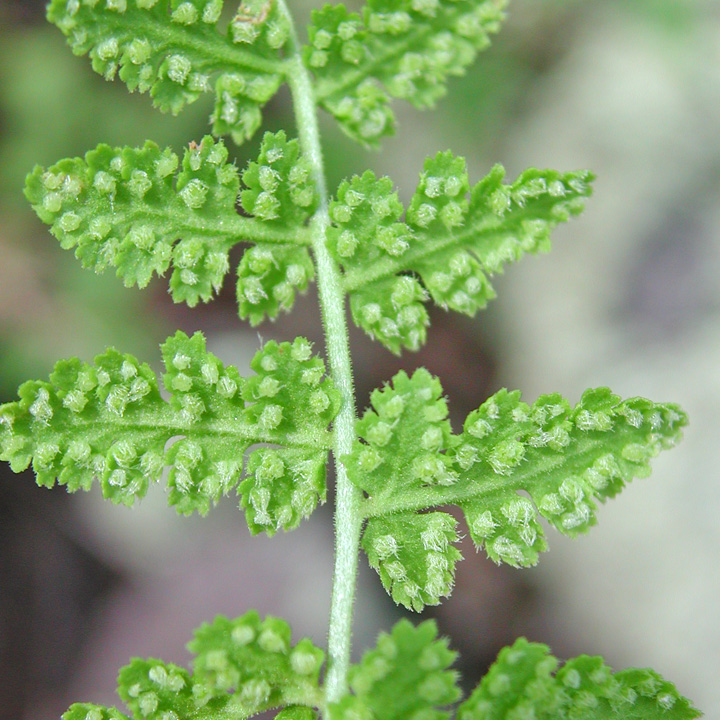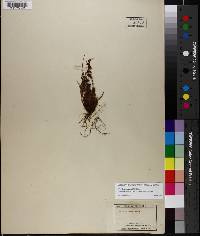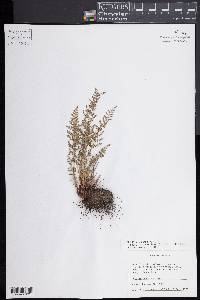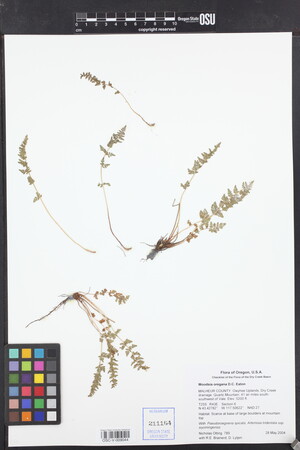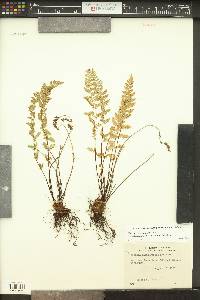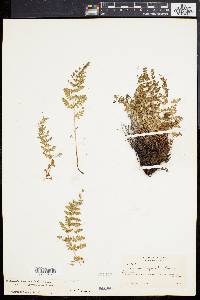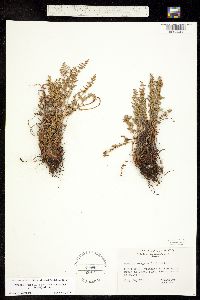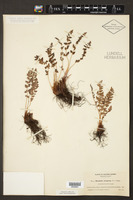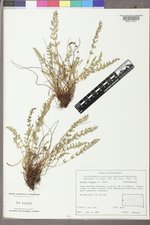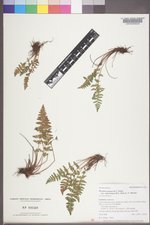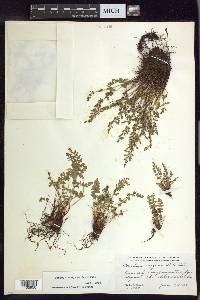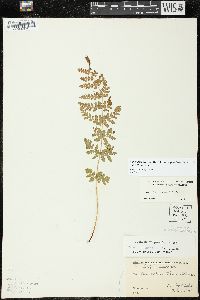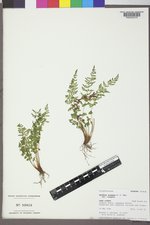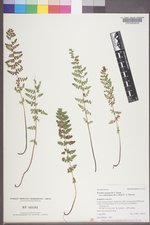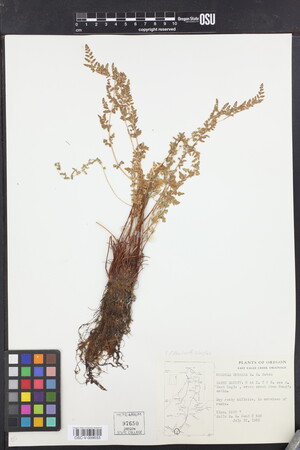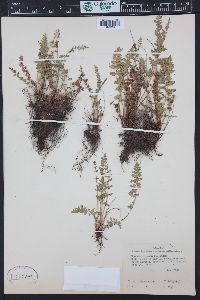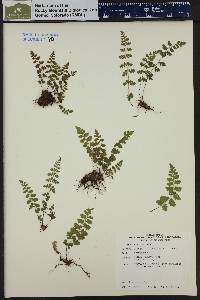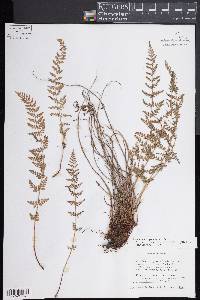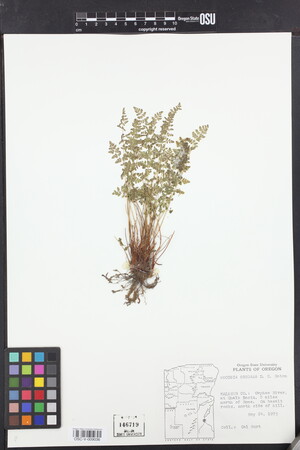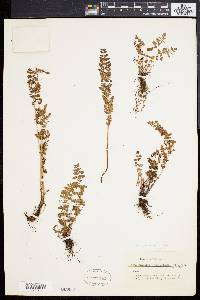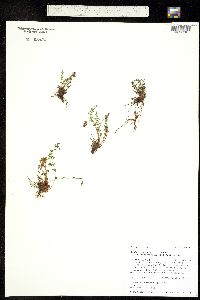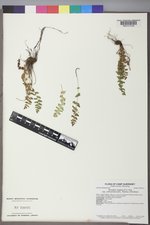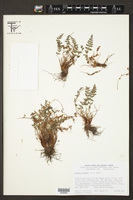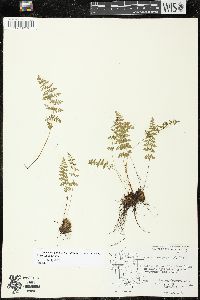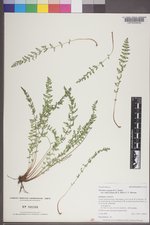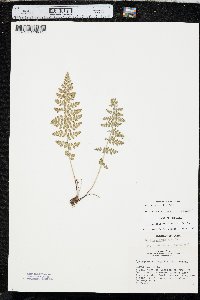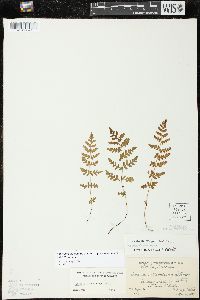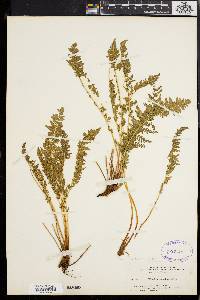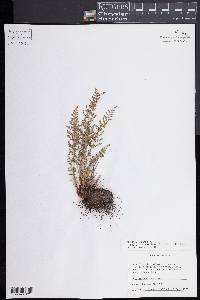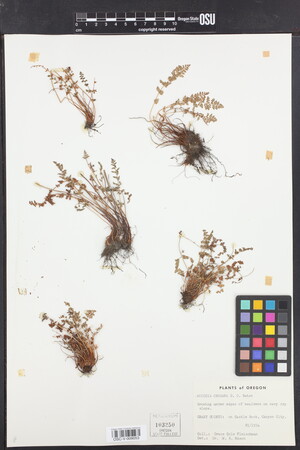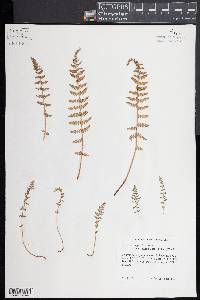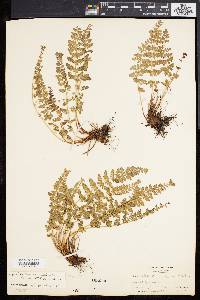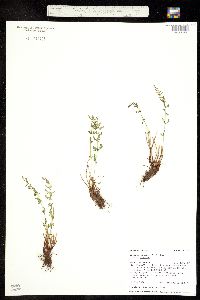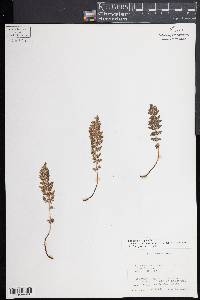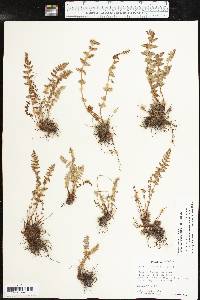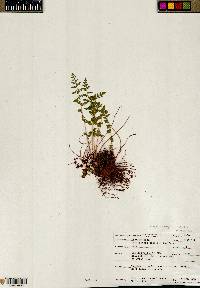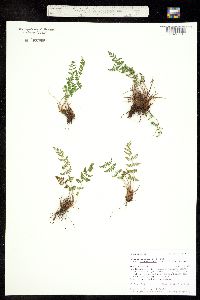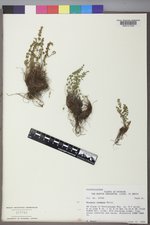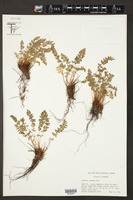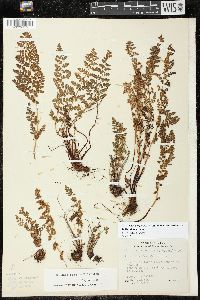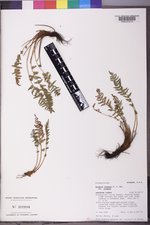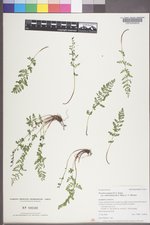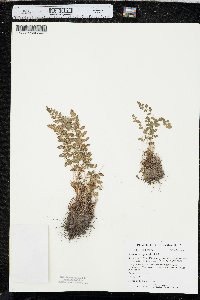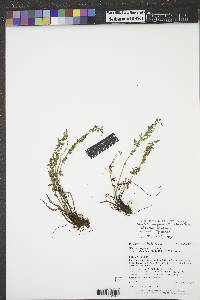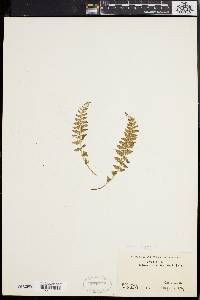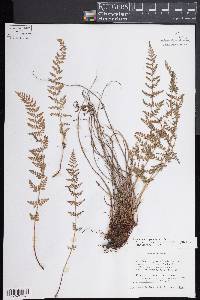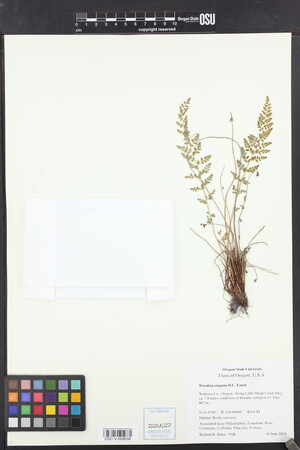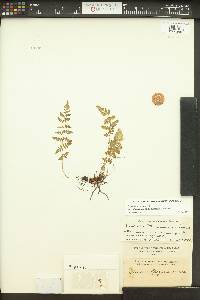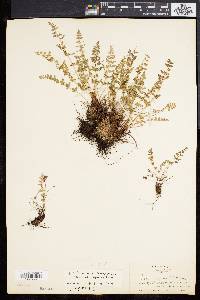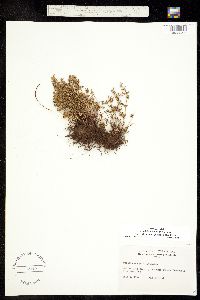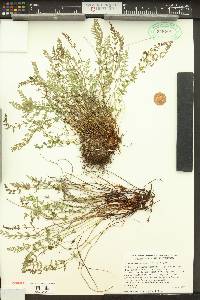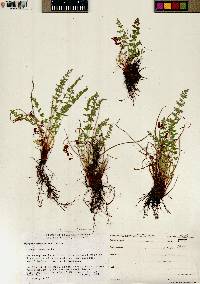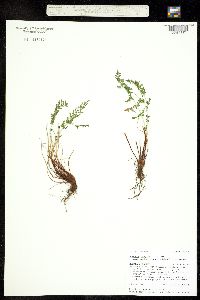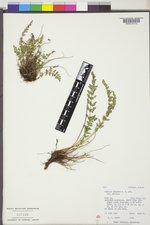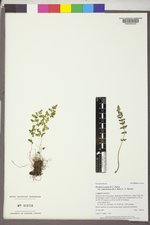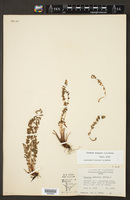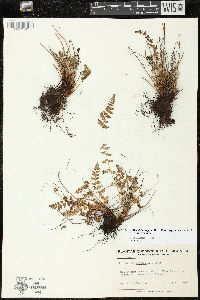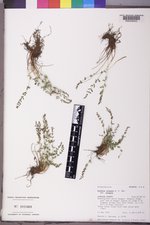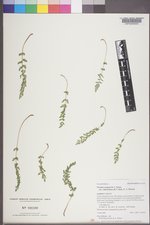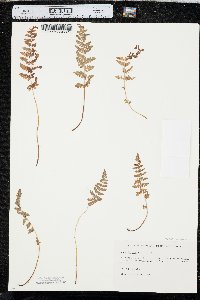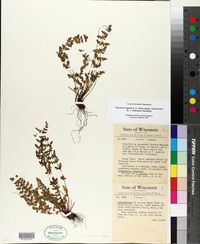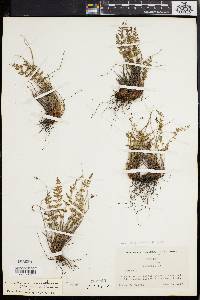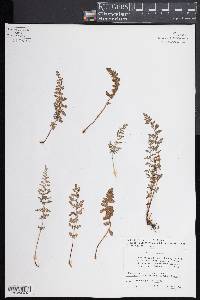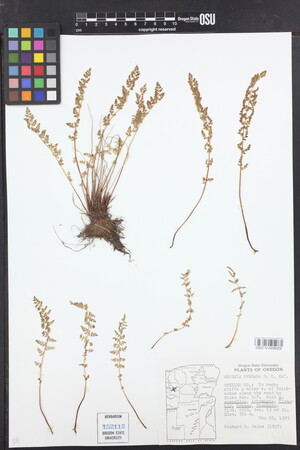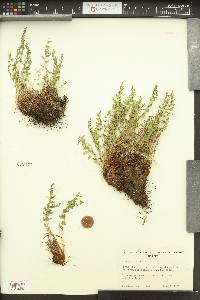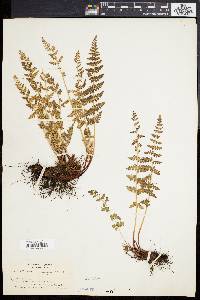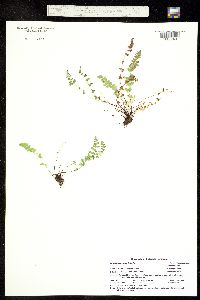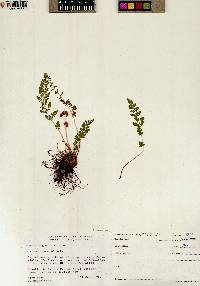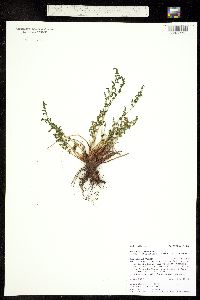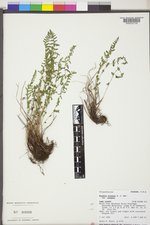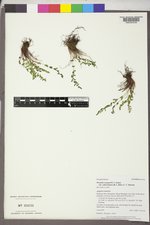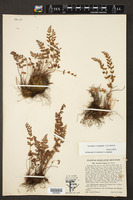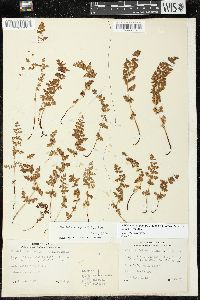Woodsia oregana
|
|
|
|
Family: Woodsiaceae
Oregon Cliff Fern, more...Oregon woodsia
|
Stems compact, erect to ascending, with few to many persistent petiole bases of unequal lengths; scales often uniformly brown but at least some bicolored with dark central stripe and pale brown margins, narrowly lanceolate. Leaves 4--25 × 1--4 cm. Petiole reddish brown to dark purple proximally when mature, not articulate above base, somewhat pliable and resistant to shattering. Blade linear-lanceolate to narrowly ovate, pinnate-pinnatifid or 2-pinnate proximally, sparsely to moderately glandular, never viscid; glandular hairs with thin stalks and slightly expanded tips; rachis with scattered glandular hairs and occasional hairlike scales. Pinnae ovate-deltate to elliptic, longer than wide, abruptly tapered to a rounded or broadly acute apex; largest pinnae with 3--9 pairs of pinnules; abaxial and adaxial surfaces glabrescent to moderately glandular, lacking nonglandular hairs or scales. Pinnules dentate, often shallowly lobed; margins nonlustrous, thin, with occasional glands, lacking cilia, rarely with 1--2-celled translucent projections. Vein tips slightly (if at all) enlarged, barely visible adaxially. Indusia of narrow, usually filamentous segments, these uniseriate for most of length, composed of ± isodiametric cells, concealed by or slightly surpassing mature sporangia. Spores averaging 39--50 µm. The variability and promiscuity of Woodsia oregana have been major sources of taxonomic difficulties in Woodsia , and more work will be necessary before relationships in this complex are fully resolved. As defined here, W . oregana comprises two subspecies that are chromosomally and biochemically distinct. In addition, the two taxa are nearly allopatric, with the diploid (subsp. oregana ) confined to the Pacific Northwest and the tetraploid (subsp. cathcartiana ) extending from the southwestern United States to eastern Canada. Isozyme studies indicate that subsp. cathcartiana is not an autotetraploid derived from known diploid populations of subsp. oregana , as was hypothesized by D. F. M. Brown (1964), and it may be more appropriate to recognize these taxa as distinct species. The morphologic features that distinguish these subspecies are very subtle, however, and they are associated primarily with differences in chromosome number. Until further systematic analyses are undertaken, these cytotypes should be maintained as subspecies of W . oregana .
General: Compact stems, erect to ascending from short rhizomes, few to many persistent petiole bases of unequal lengths, scales uniformly brown with some bicolored, narrowly lanceolate. Leaves: Tufted fronds, 4-25 cm long by 1-4 cm wide, petiole reddish brown to dark purple below; blade linear-lanceolate to narrowly ovate, twice pinnate, sparsely to moderately glandular; pinnae ovate deltate to elliptic, longer than wide, abruptly tapering to a rounded or broadly acute apex, appearing triangular; largest pinnae with 3-9 pairs of pinnules; surfaces glabrescent to moderately glandular above and below, pinnules dentate, often shallowly lobed, margins non-lustrous, thing, lacking cilia. Sporangia: Sori submarginal, with indusia of narrow, usually filamentous segments, rupturing into slender segments shorter than sporangia and often concealed at maturity. Ecology: Found on a variety of substrates, often in cliffs, along ledges and on rocky slopes from 5,500-11,500 ft (1676-3505 m); sporulates summer-fall. Notes: FNA identifies regional specimens in the southwest as ssp. cathcartiana. This species has lots of taxonomic problems because of its “promiscuity” (FNA). There are quite a few relationships that are not resolved, which its variability attests to. Distinguished from other Woodsia by the ragged pinnule margins that have a lack of translucent projections or filaments. Etymology: Woodsia is named after Joseph Woods (1776-1864) an English botanical author, while oregana means of or from the state of Oregon. Sources: FNA 1993, Dittmer et al. 1954, Kearney and Peebles 1969 FNA 1993, Dittmer et al. 1954, Kearney and Peebles 1969 Common Name: Oregon cliff fern Rarity: None General: Compact stems, erect to ascending from short rhizomes, few to many persistent petiole bases of unequal lengths, scales uniformly brown with some bicolored, narrowly lanceolate. Leaves: Tufted fronds, 4-25 cm long by 1-4 cm wide, petiole reddish brown to dark purple below; blade linear-lanceolate to narrowly ovate, twice pinnate, sparsely to moderately glandular; pinnae ovate deltate to elliptic, longer than wide, abruptly tapering to a rounded or broadly acute apex, appearing triangular; largest pinnae with 3-9 pairs of pinnules; surfaces glabrescent to moderately glandular above and below, pinnules dentate, often shallowly lobed, margins non-lustrous, thing, lacking cilia. Sporangia: Sori submarginal, with indusia of narrow, usually filamentous segments, rupturing into slender segments shorter than sporangia and often concealed at maturity. Ecology: Found on a variety of substrates, often in cliffs, along ledges and on rocky slopes from 5,500-11,500 ft (1676-3505 m); sporulates summer-fall. Ethnobotany: Unknown Etymology: Woodsia is named after Joseph Woods (1776-1864) an English botanical author, while oregana means of or from the state of Oregon. Synonyms: None Editor: SBuckley, 2010 Rhizome-scales light brown, often lacking a dark stripe, lance-linear, seldom over 0.5 mm wide, subentire; lvs 7-25 cm; petiole dark brown toward the scaly base, not articulate, without long hairs; blade lanceolate, 1-5 cm wide, acuminate, slightly narrowed below, subbipinnate to subtripinnate, glabrous to glandular (the glands cylindric), but without long hairs; pinnae 7-17 pairs, deltoid to lanceolate, sessile, mostly bipinnatifid with 5-7 pairs of segments, or merely pinnatifid with toothed segments; indusial segments several, narrow, 2-3 cells wide at the base, commonly uniseriate distally; 2n=76, 152. Rock crevices; cordilleran region from B.C. and Alta. to Calif. and N.M., and irregularly e. to Okla., Wis., Sask., Que., w. N.Y., and Vt. Strongly glandular plants from the Great Lakes region (esp. in Minn. and Wis.) have been called var. cathcartiana (B. L. Rob.) C. V. Morton. At least some of these are tetraploid, in contrast to the diploid, less glandular or glabrous var. oregana. Gleason, Henry A. & Cronquist, Arthur J. 1991. Manual of vascular plants of northeastern United States and adjacent Canada. lxxv + 910 pp. ©The New York Botanical Garden. All rights reserved. Used by permission. |

